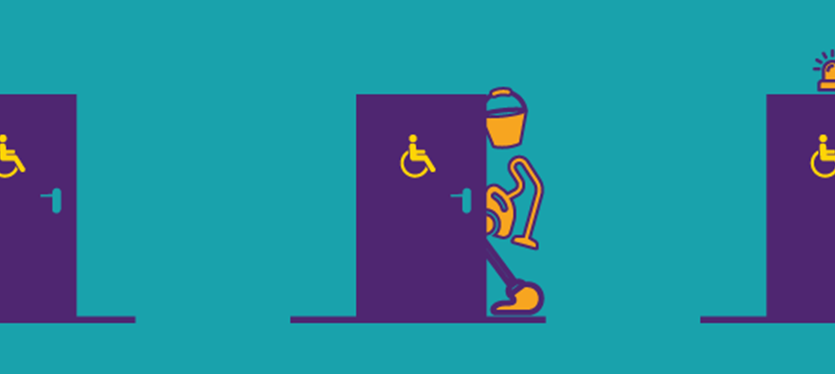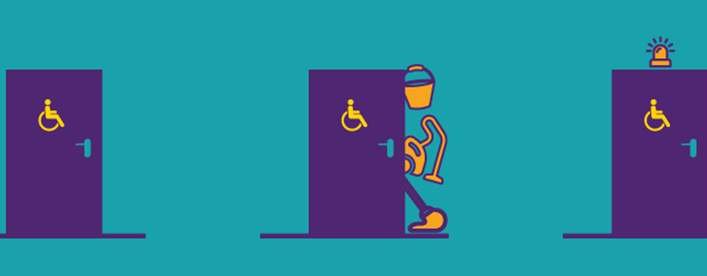Are you upgrading, modifying or installing an accessible toilet?


Get ready for World Toilet Day!
Helpful guidance for venues
Ahead of World Toilet Day on Saturday 19 November, we’ve been thinking about how our venues can make sure their accessible toilets are clean, spacious and, most importantly, safe.
Building guidance recommends that accessible toilets have an emergency assistance alarm system with a red pull cord that is easily identifiable and reachable from the toilet and the floor close to the toilet. Far too often these cords are tied up, cut short or wrapped around other equipment meaning people in distress are unable to raise the alarm, leaving them trapped with no way to ask for help. We try to help to change that.
We hope our guidance is a helpful and useful way to make sure your accessible toilet is in tip-top condition. As always, feel free to get in touch with us by email or on social media if you have any questions or need more help / advice.
1.Communication
If you have an accessible toilet, should about it! Make sure your website has information about your accessible toilet and let your social media followers know by regularly posting about them. In our 2021 Access Survey 92% of people look for disabled access information before visiting somewhere new.
2.Signage
First things first: make sure your accessible loo is obvious. It instils confidence in people if the disabled toilet is quick to spot and easy to find. Make life easier for everyone by sign-posting your accessible toilets with clear notices and ensure that the route is as clear and spacious as possible. Remember not all disabilities, impairments or long term conditions are visible.
3.Set the cords free
We’ve made tens of thousands of accessible toilets safer with our Red Cord Cards and we continue to be inundated with requests, which tells us that people keep finding unsafe toilets with tied up or damaged cords. Make sure your accessible loo has a red cord that hangs freely to the ground, and feel free to pop one of our Red Cord Cards on it to make sure people know what it’s for, and why it shouldn’t be tied up or shortened.
4.Test for safety
While we’re on the subject… if you have an accessible toilet with a red cord, can you remember the last time someone pulled it? It’s worth testing it to be certain everything is in order so you know your visitors who use the disabled toilet are safe. Just make sure you know how to switch the alarm off and reset! Train your staff in this and add regular checks to the staff rota.
5.Toilets
Your accessible toilet will likely be higher than a standard toilet so that it’s at a similar height to a wheelchair, which makes transferring easier for people. It’s also useful to know that the flush should be on the side away from the wall so that people who use wheelchairs can reach it from their wheelchair.
6.Grab rails
The main use for grab rails is to support people who need to transfer from a wheelchair, or for balance. This means the grab rails need to be secure enough to support weight bearing so it’s worth checking regularly that all fixtures are in place and secure. It helps if grab rails adjacent to toilets can be raised and lowered to allow for easier manoeuvring.
It’s good to have a horizontal grab rail fixed to the inners side of the toilet door so that’s easier for people to close the door independently. Where the door has a self-closing mechanism, check the time it takes to close so that it doesn’t shut too soon and before the user has had time to move out of the way.
7.Sinks
Sinks are usually fitted as close to the toilet as possible, and at a height that will allow a wheelchair user to position themselves close enough. The same goes for hand dryers: make sure these are positioned at a height that is reachable for wheelchair users. Remember that the soap, paper towels, and hygiene products should be at a height that that is within reach and close to the sink.
8.Waste bins
These are essential but they can be a nuisance by taking up valuable space. Try to keep the size of the bin in keeping with the size of the room. If it’s proportionally too big it’ll take up too much room, and don’t put it next to the toilet where someone would need to transfer. And bins that are easy to use and don’t require foot operation.
9.Space
The bigger the better! Allow as much space for your accessible toilet as you can, so that there’s room for people to move around, particularly people who use wheelchairs, mobility aids, or have carers to help. It’s also helpful if the door opens outwards so that it doesn’t take up any additional space inside, and it means nobody is likely to find themselves trapped.
Please don’t store unnecessary items in the accessible toilet. It’s there for disabled people to use, not to store a wall of tinned tomatoes, surfboards or piles of broken mannequin parts. Yes, these are all the weird things reported as being stored in disabled toilets!
10.Changing Places
If you have a Changing Places toilet make sure you let people know! They’re an asset to any venue or location and will definitely be a top attraction for disabled people. 81% of disabled people who responded to our 2021 Access Survey said that accessible toilets will make it easier for them to visit places.
11.Mirrors, coat hook, shelving
Make sure mirrors can be viewed by people both standing and sitting, and a coat hook is helpful. A shelf will allow people to put their equipment or belongings out of the way safely and hygienically. Again, make sure these items are at a good height for a seated position so that they can be reached by wheelchair users.
12. Good lighting
A brightly lit accessible loo is a must, especially for people who are visually impaired. If the lights aren’t automatic, make sure the light switch is easy to find and reach. It can help to have a light switch in a colour that contrasts with the wall which will help visually impaired people. Alternatively, a pull cord should reach to a seated position and can be easier to use if it’s thicker or has a plastic pull ring attached to it.
13. Locks
Where possible fit a RADAR lock because many disabled people carry these with them to unlock accessible toilets. Make sure your staff know where your RADAR keys and spares are kept. Avoid key-pads, and don’t make people travel from one end of a shopping centre to another just to use the loo.
Before you go...
We love this paper from Motion Spot on designing a stylish accessible toilet.


 Follow Euan's Guide on Instagram
Follow Euan's Guide on Instagram
 Follow Euan's Guide on LinkedIn
Follow Euan's Guide on LinkedIn
 Follow Euan's Guide on Facebook
Follow Euan's Guide on Facebook

